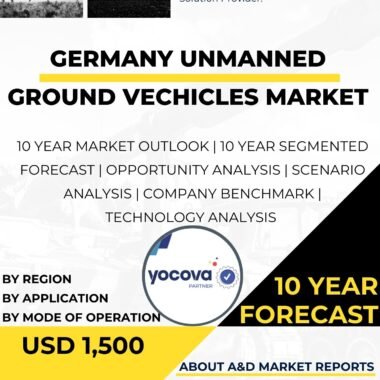Description
Unmanned Ground Vehicles (UGVs) are a critical component of modern military operations, offering versatility, mobility, and enhanced safety in various military tasks. In Canada, UGVs have become an integral part of the Canadian Armed Forces (CAF), supporting a wide range of missions, including reconnaissance, surveillance, logistics support, explosive ordnance disposal, and search and rescue operations. This article explores the importance of Unmanned Ground Vehicles in Canada, their history, types, technology, challenges, and their role in enhancing the CAF’s operational capabilities.
The use of Unmanned Ground Vehicles in Canada traces its roots to the early developments of robotics and autonomous systems in military applications. In the latter half of the 20th century, advancements in robotics and computing technology led to the development of early UGV prototypes for military and research purposes.
Over time, UGVs have evolved from basic remote-controlled vehicles to sophisticated, autonomous systems capable of navigating complex terrains and executing various tasks with minimal human intervention. Canada’s interest in UGVs grew as their potential benefits for military operations became evident.
One of the earliest UGVs used by the CAF was the Radio-Controlled Demolition Vehicle (RCDV), which was employed for explosive ordnance disposal (EOD) tasks. The RCDV allowed EOD personnel to remotely approach and disarm explosive devices, minimizing the risks to human operators.
In recent years, Canada has focused on the development and acquisition of advanced UGVs to support various military tasks and improve operational efficiency. Some of the prominent UGVs used by the CAF include the TITAN Unmanned Ground Vehicle and the PACKBOT.
The TITAN Unmanned Ground Vehicle is a versatile and robust UGV designed for logistics support and transportation of heavy loads on the battlefield. With its ability to traverse challenging terrains and carry heavy equipment, the TITAN contributes to the efficiency and effectiveness of ground operations.
The PACKBOT is a smaller and more portable UGV used for reconnaissance, surveillance, and EOD tasks. Its compact design and agility allow it to navigate confined spaces and access areas that might be difficult for larger vehicles or human operators to reach.
The CAF actively explores and integrates various types of UGVs, tailoring their capabilities to specific operational requirements. The UGVs are equipped with advanced sensors, cameras, and communication systems, enabling them to carry out tasks autonomously or under remote human control.
Autonomous capabilities play a vital role in enhancing the effectiveness of UGVs. Advanced UGVs are equipped with perception algorithms and sensor fusion technologies, allowing them to perceive and interpret their surroundings accurately. These autonomous capabilities enable UGVs to operate with greater independence, adapt to changing environments, and execute missions with minimal human intervention.
UGVs are especially valuable for tasks that involve high-risk environments or situations where human presence could be hazardous. For instance, in explosive ordnance disposal, UGVs can be used to approach and disarm improvised explosive devices (IEDs) without exposing EOD personnel to potential dangers.
In addition to military applications, UGVs have shown significant potential in humanitarian missions and disaster relief efforts. These versatile machines can navigate through hazardous environments, provide reconnaissance in disaster-affected areas, and deliver essential supplies to victims without endangering human responders.
The integration of UGVs into the CAF’s operations also addresses the challenge of minimizing the logistical footprint and reducing risks to human personnel. UGVs can assist in transporting equipment, ammunition, and supplies, freeing up human resources for other critical tasks.
Challenges associated with UGVs in Canada relate to ensuring their reliable operation in various environmental conditions and terrains. UGVs must be capable of navigating rough and unpredictable landscapes, including forests, deserts, urban environments, and snowy regions.
To overcome these challenges, UGVs in Canada are designed and tested to operate in diverse terrains and climates. Testing and evaluation are conducted to verify the UGVs’ performance, adaptability, and endurance in various scenarios.
Moreover, UGVs are vulnerable to cyber threats and potential interference from adversaries seeking to disrupt their operations. The CAF addresses these concerns by implementing robust cybersecurity measures, encryption protocols, and secure communication systems to protect UGVs from unauthorized access and manipulation.
Training and expertise are vital for operating UGVs effectively. The CAF prioritizes training personnel to proficiently use and maintain UGVs in various operational contexts. Regular exercises and simulations are conducted to ensure that UGV operators can respond appropriately to different scenarios.
As with any emerging technology, ethical considerations and adherence to international laws and regulations are critical aspects of using UGVs in military operations. Canada is committed to employing UGVs responsibly and in compliance with international norms to ensure their humanitarian and military applications align with ethical guidelines.
The future of UGVs in Canada will likely see continued advancements in technology and capability. Research and development efforts will focus on enhancing autonomous features, miniaturizing UGVs, and expanding their communication and networking capabilities.
In conclusion, Unmanned Ground Vehicles play a crucial role in enhancing the operational capabilities of the Canadian Armed Forces. These versatile machines are employed for a wide range of tasks, including reconnaissance, surveillance, logistics support, and EOD operations. UGVs offer the CAF increased mobility, efficiency, and safety in various operational environments, minimizing risks to human personnel and improving the overall effectiveness of military missions.
Canada’s commitment to the development and integration of advanced UGVs underscores its dedication to leveraging technology to enhance military capabilities and adapt to evolving security challenges. As UGV technology continues to progress, Canada’s armed forces will continue to benefit from these unmanned systems, expanding their capabilities and contributions in both military and humanitarian operations.
Unmanned Ground Vehicles will remain a critical asset in Canada’s military strategy, providing the CAF with agile and adaptable solutions to address a diverse range of operational requirements on the modern battlefield.




